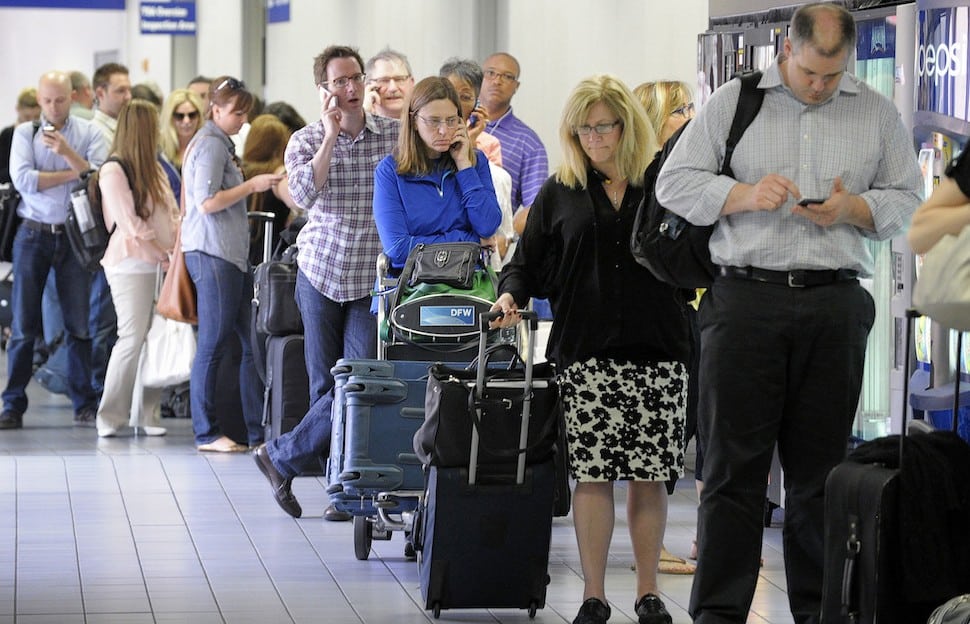Three U.S. airline CEOs on Tuesday downplayed criticism that the industry is too reliant on antiquated and inefficient computer systems, but all generally acknowledged carriers can do a better job of investing in technology.
The CEOs – Mark Dunkerley of Hawaiian Airlines, Gary Kelly of Southwest Airlines, and Brad Tilden of Alaska Airlines — argued airline systems are more complex than what other industries use, making it unfair to compare airlines with other businesses. They also noted many passenger complaints come not from the outages themselves, but the fact it takes airlines longer than the typical business to return to regular operations after any disruption.
The CEOs of Etihad, Expedia, Routehappy, and More Are Speaking at Skift Global Forum 2016. Join Us.
“What’s somewhat unique about airlines is our customers are experiencing our product as we are making it,” Southwest’s Kelly said at a panel discussion in Washington, D.C. organized by Airlines for America, an industry trade group. “If we suspend flying for an hour, it’s not a matter of turning the airline back on. It takes time to recover. That’s true for any logistics business. But an online service could go down for an hour and turn back on, and you’d never know the difference.”
It has not been a good summer for airline technology. In July, Southwest was forced to cancel thousands of flights for several days after a router failed and a backup system did not work as planned. In August, Delta Air Lines had its own technological meltdown when a power failure knocked out key systems. Delta’s backups also did not kick in properly, and the airline’s operation was crippled for days. And last week, British Airways had similar issues, if on a smaller scale.
The twin U.S. failures made passengers upset and persuaded two senators to ask airlines questions about their computer systems. Last month, Sens. Richard Blumenthal (D-Conn.) and Edward J. Markey (D-Mass.) wrote to 13 airlines, saying they were “…concerned with recent reports indicating that airlines’ IT systems may be susceptible to faltering because of the way they are designed and have been maintained.” Airlines are supposed to respond by Sept. 16.
Several Southwest unions, including ones representing pilots, flight attendants and baggage handlers, had called on Kelly and COO Mike Van de Ven to resign for mishandling the airline’s recent outage. But both signaled they will stay, and they were supported by the carrier’s board. Several of the unions had been in contract talks with the airline, and they appeared to try to use technology problems as a chance to increase their leverage over company management.
While the CEOs on Tuesday said they’re mostly confident with their systems, they noted airlines have more complicated technological platforms than three decades ago, and that has added complexity to each carrier’s operation.
Where once Alaska Airlines had essentially two computerized systems — its reservations platform, and the technology on each aircraft — it now has hundreds, controlling everything from maintenance to crew scheduling to its mobile app.
“All these systems have to talk to each other,” Tilden said, adding that when they cannot, airlines sometimes must stop flying. Several years ago, he said, Alaska had to suspend its operations for half a day because a “minor system” failed.
Tilden said Alaska now spends three to four times as much on technology as it did five years ago. “But it’s complicated,” he said. “We do need to modernize these systems and probably make the linkage between the systems better than they are today.”
Caution First
Hawaiian’s Dunkerley said airlines often err on the side of caution when they stop flying during an outage. Another industry might try to continue operations, but that’s not prudent for airlines, he said.
“Safety is paramount in our industry,” Dunkerley said. “If we have any moment in time when we don’t know, then the planes don’t go. It really is that simple. That’s frustrating for people, I understand that. But better that we be safe.”
Dunkerly also argued the outages are relatively minor, and tend to be short. The bigger problem, he said, is that after an outage, airlines have planes and crews out of place. And since pilots and flight attendants usually cannot simply say they’re willing to work a longer day, that hurts the operation for a long period. Regulations limit how much crews can work.
“You have very limited ability to get your pilots to say, ‘OK, we’ll just stick around for three hours and continue the journey,”‘ he said. “The computer outage may be an hour. It maybe two hours. It may be three hours. You may feel the impact of it for three days.”
Hawaiian has not had an outage in awhile, but it’s a topic airline employees think about often.
“I can tell you when some of the other airlines suffered outages, we weren’t laughing,”Dunkerly said. “We’re one circuit breaker away from having to deal with something similar.”
Subscribe to Skift Pro to get unlimited access to stories like these
{{monthly_count}} of {{monthly_limit}} Free Stories Read
Subscribe NowAlready a member? Sign in here
Subscribe to Skift Pro to get unlimited access to stories like these
Your story count resets on {{monthly_reset}}
Already a member? Sign in here
Subscribe to Skift Pro to get unlimited access to stories like these
Already a member? Sign in here
